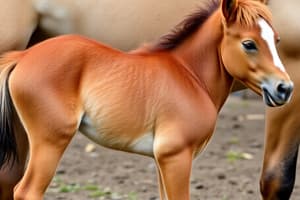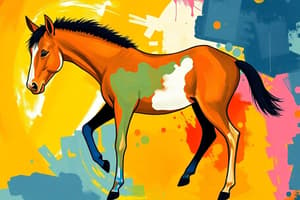Podcast
Questions and Answers
In a foal presenting with diarrhea, what is the primary justification for performing a full colic evaluation?
In a foal presenting with diarrhea, what is the primary justification for performing a full colic evaluation?
- To assess the foal's hydration status and electrolyte balance.
- To rule out the presence of severe gastrointestinal compromise, such as a strangulating lesion. (correct)
- To identify the specific infectious agent causing the diarrhea.
- To determine the extent of intestinal inflammation and mucosal damage.
What is the rationale behind the recommendation to avoid dry lots when trying to prevent diarrhea in foals?
What is the rationale behind the recommendation to avoid dry lots when trying to prevent diarrhea in foals?
- Dry lots can become heavily contaminated with pathogens, increasing the risk of exposure to infectious agents. (correct)
- Dry lots often lack sufficient drainage, leading to the accumulation of stagnant water and bacterial overgrowth.
- Dry lots typically have poor ventilation, creating an environment conducive to the spread of airborne pathogens.
- Dry lots tend to have higher concentrations of parasitic larvae, increasing the risk of parasitic infections.
Why is E. coli generally not considered a primary cause of diarrhea in foals, despite its potential presence?
Why is E. coli generally not considered a primary cause of diarrhea in foals, despite its potential presence?
- _E. coli_ is effectively neutralized by the antibodies present in the mare's colostrum, limiting its ability to cause diarrhea in foals.
- _E. coli_ is primarily a commensal organism in foals and only causes diarrhea in immunocompromised individuals.
- Foals develop a natural immunity to _E. coli_ during the first few weeks of life, preventing it from causing significant diarrhea.
- _E. coli_ is more likely to cause systemic infections such as sepsis and bacteremia, rather than direct gastrointestinal disease. (correct)
A foal is diagnosed with diarrhea caused by Clostridioides difficile. Which aspect of this disease's etiology in foals differentiates it from its presentation in adult horses?
A foal is diagnosed with diarrhea caused by Clostridioides difficile. Which aspect of this disease's etiology in foals differentiates it from its presentation in adult horses?
What is the significance of identifying both the toxin and isolating the organism from feces when diagnosing Clostridioides difficile in foals with diarrhea?
What is the significance of identifying both the toxin and isolating the organism from feces when diagnosing Clostridioides difficile in foals with diarrhea?
What differentiates C. perfringens type A from type C in foals regarding the severity and treatment response of diarrhea?
What differentiates C. perfringens type A from type C in foals regarding the severity and treatment response of diarrhea?
What is the most critical reason for implementing isolation protocols for foals diagnosed with rotavirus or Clostridium species-related diarrhea?
What is the most critical reason for implementing isolation protocols for foals diagnosed with rotavirus or Clostridium species-related diarrhea?
What is the underlying mechanism leading to osmotic diarrhea in foals with nutritional diarrhea?
What is the underlying mechanism leading to osmotic diarrhea in foals with nutritional diarrhea?
What is the primary mechanism of action of biosponge in the treatment of diarrhea in foals?
What is the primary mechanism of action of biosponge in the treatment of diarrhea in foals?
How does Lawsonia intracellularis cause diarrhea and protein loss in weanling foals, and what is a key clinical sign associated with this?
How does Lawsonia intracellularis cause diarrhea and protein loss in weanling foals, and what is a key clinical sign associated with this?
What is the significance of detecting concurrent bacteremia in foals with severe, watery diarrhea and septic shock?
What is the significance of detecting concurrent bacteremia in foals with severe, watery diarrhea and septic shock?
Why are foals more susceptible to Salmonella infections between 12 hours and 4 months of age?
Why are foals more susceptible to Salmonella infections between 12 hours and 4 months of age?
What is the primary reason broad-spectrum antibiotics are used to treat Salmonella infections in foals, contrasting with the approach in adult horses?
What is the primary reason broad-spectrum antibiotics are used to treat Salmonella infections in foals, contrasting with the approach in adult horses?
Why is washing the mare's udder recommended as part of the prevention strategy for diarrhea in foals?
Why is washing the mare's udder recommended as part of the prevention strategy for diarrhea in foals?
Besides supportive care, what specific therapeutic intervention is often used to treat coronavirus infections in foals?
Besides supportive care, what specific therapeutic intervention is often used to treat coronavirus infections in foals?
What is the rationale for using lactase in the treatment of diarrhea in foals?
What is the rationale for using lactase in the treatment of diarrhea in foals?
How does the use of hyperimmune plasma in treating C. perfringens and C. difficile infections in foals potentially improve outcomes, and what factors should be considered when using this treatment?
How does the use of hyperimmune plasma in treating C. perfringens and C. difficile infections in foals potentially improve outcomes, and what factors should be considered when using this treatment?
Why is monitoring daily body weights important in foals with diarrhea undergoing fluid therapy, what is the most important to consider in relation to this?
Why is monitoring daily body weights important in foals with diarrhea undergoing fluid therapy, what is the most important to consider in relation to this?
In a foal with diarrhea, what is the primary goal of fluid therapy beyond simply correcting dehydration?
In a foal with diarrhea, what is the primary goal of fluid therapy beyond simply correcting dehydration?
A farm has a history of endemic rotavirus outbreaks in foals. What preventative measure involving the mare would be most effective in providing passive immunity to the foal?
A farm has a history of endemic rotavirus outbreaks in foals. What preventative measure involving the mare would be most effective in providing passive immunity to the foal?
Flashcards
Diarrhea in Foals
Diarrhea in Foals
A frequent problem in foals where up to 80% experience an episode before 6 months of age.
Diarrhea as an indicator
Diarrhea as an indicator
Severe gastrointestinal tract involvement, indicating possible strangulation.
Foal Heat Diarrhea
Foal Heat Diarrhea
Occurs in first 1-2 weeks, linked to GI flora development. Usually mild and needs minimal treatment.
Nutritional Diarrhea
Nutritional Diarrhea
Signup and view all the flashcards
Infectious Diarrhea
Infectious Diarrhea
Signup and view all the flashcards
Clostridium perfringens
Clostridium perfringens
Signup and view all the flashcards
C. perfringens Type C
C. perfringens Type C
Signup and view all the flashcards
Clostridioides difficile exotoxins
Clostridioides difficile exotoxins
Signup and view all the flashcards
Clostridial Diarrhea Prevention
Clostridial Diarrhea Prevention
Signup and view all the flashcards
Salmonella
Salmonella
Signup and view all the flashcards
Rotavirus
Rotavirus
Signup and view all the flashcards
Rotavirus Prevention
Rotavirus Prevention
Signup and view all the flashcards
Coronavirus
Coronavirus
Signup and view all the flashcards
Lawsonia intracellularis
Lawsonia intracellularis
Signup and view all the flashcards
Signs of Lawsonia
Signs of Lawsonia
Signup and view all the flashcards
Treating/Preventing Lawsonia
Treating/Preventing Lawsonia
Signup and view all the flashcards
Diagnosing Diarrhea
Diagnosing Diarrhea
Signup and view all the flashcards
Blood Work for Diarrhea
Blood Work for Diarrhea
Signup and view all the flashcards
Treatment of Diarrhea
Treatment of Diarrhea
Signup and view all the flashcards
Fluid Therapy Goals
Fluid Therapy Goals
Signup and view all the flashcards
Study Notes
Diarrhea in Foals
- Diarrhea is a common issue in foals, with up to 80% experiencing at least one episode before 6 months of age.
- Causes can range from self-limiting to life-threatening.
- Diagnosing the specific cause of diarrhea can be challenging based solely on clinical signs.
Assessment of Diarrhea
- It's important to confirm that the foal truly has diarrhea.
- Diarrhea can indicate a severe gastrointestinal issue, such as a strangulating lesion.
- A full colic evaluation is necessary for foals presenting with diarrhea, including:
- Nasogastric tube
- Abdominal ultrasound
- Digital palpation
Types of Diarrhea
- Diarrhea can be be a primary infectious or non-infectious issue
- Diarrhea can be secondary to sepsis or Neonatal Asphyxia Syndrome (necrotizing enteritis).
Primary Causes of Diarrhea in Neonates
- Non-infectious causes:
- Foal heat diarrhea
- Nutritional factors
- Infectious causes:
- Clostridium perfringens
- Clostridioides difficile
- Salmonella enterica
- Rotavirus
- Coronavirus
- Enterococcus durans
- Cryptosporidium parvum
- Strongyloides westerii
Foal Heat Diarrhea
- Typically occurs in the first 1-2 weeks of life, affecting up to 80% of foals.
- Not related to the mare's estrus cycle.
- Can affect orphaned foals or those on milk replacer without dam contact.
- May involve the development of GI flora or small intestinal hypersecretion.
- Usually mild and rarely requires treatment
Nutritional Diarrhea
- Related to:
- Overingestion of milk
- Overfeeding orphaned or sick foals
- Incorrect milk replacer mixing
- Osmotic diarrhea arises from dietary mistakes overwhelming the small intestine's capacity and hindgut lactose fermentation.
- Typically mild and addressed with diet adjustment.
Infectious Causes of Diarrhea
- Often associated with more severe disease compared to non-infectious diarrhea.
- 50% of foals with diarrhea develop bacteremia.
- Mare's feces and the environment act as frequent sources of infectious agents.
- E. coli is not considered a primary cause of diarrhea, but it can lead to sepsis and bacteremia.
Clostridium perfringens
- This G+ anaerobic, spore-forming bacteria can cause illness in foals, even as young as 36 hours and under 10 days old.
- It can also affect adult horses.
- Often connected to ingesting colostrum that contains trypsin inhibitors.
- It exists as a soil pathogen, present in the environment and dry lots resulting in annual outbreaks in endemic farms.
- Types A and C are significant in horses.
- C. perfringens type A:
- Isolated from 90% of healthy 3-day-old foals.
- Causes moderate severity disease with good treatment response.
- Enterotoxin is accountable for severe disease.
Studying That Suits You
Use AI to generate personalized quizzes and flashcards to suit your learning preferences.




